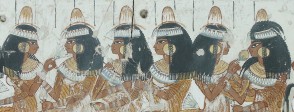Use the pictures of Nebamun’s feast and the list of items to observe in For the classroom. Challenge students to find everything on the list – you could give them hard copies of the painting and the list items on small cards to match. Then look at a small selection of different people in detail. Do these people sit or stand in different ways? How are they dressed? What are they doing?
The following activities explore aspects of Egyptian life which arise out of elements of the painting. Use the resources in For the classroom and the hundreds of images available on the British Museum website to broaden the enquiry. Each activity involves initial research leading on to creative outcomes.
Plan an ancient Egyptian party. Ask students to research what the ancient Egyptians liked to eat and drink and decide what might be suitable for their party. Will there be entertainment and if so, what? Research the kinds of entertainments Egyptians enjoyed at parties, such as music, dance, juggling, acrobatics, songs and storytelling and follow up with individual or group performances. To find your entertainers, hold an ancient Egyptian talent show.
Discuss how comfortable and practical Egyptian clothing would have been. What were clothes made from? Do students prefer the clothes they wear? What were the differences between the clothing worn by ordinary Egyptians and those of the wealthy? What can we tell from people’s clothes today? Make Egyptian costumes and hold a fashion show.
Whatever their age, sex or status, ancient Egyptians wore jewellery. Ask students to collect more images of ancient Egyptian jewellery and find out what materials ancient Egyptian jewellers used and where the materials came from. Do modern jewellers use any of the same materials? Do we still wear the same types of jewellery? Make some Egyptian jewellery.
A lot of Egyptian jewellery included amulets. Find out more about the different types of amulets used by the ancient Egyptians. Do a special enquiry about the amulets used in mummification and burial. Find out which of these were also worn in life. ¬Do people nowadays wear charms or protective symbols? Ask students to think of examples. Make versions of the most common Egyptian amulets.
Ancient Egyptian men, women and children all wore makeup. Using the resources in For the classroom and A bigger picture, discuss the practical and aesthetic reasons for wearing makeup, and explore Egyptian hairstyles and cosmetics. Why did the Egyptians start wearing makeup? What did they make it from? Why did children have their heads shaved? Why did adults wear wigs? Working in pairs, get the students to experiment with Egyptian hairstyles and makeup, or invite a face painter to come and do Egyptian makeovers.
The songs Egyptians sang at parties were the equivalent of our pop songs. Print out some of the lyrics in For the classroom and give them to groups to discuss. How do the words compare with modern songs? What do they tell us about life and love in ancient Egypt? Ask students to try fitting the words to a modern tune or to make up a tune and hold a song contest.
Here are two broader topics for enquiry.
Was it better to be a woman in ancient Egypt or nowadays? Start by using the painting and the objects in A bigger picture to create a list of things known and things to be researched. After more enquiries, make comparisons with contemporary society. Students might imagine how an ancient Egyptian woman travelling to our time would feel and then how would a modern woman might feel if she woke up in ancient Egypt? What would she like? What might she find difficult?
The feast in the painting is not a real one, but something Nebamun wanted to enjoy in the next life: a great celebration with all his family and friends. Ask students why they think this was this so important to him? Why did he think the painting would make it possible? Use these questions to explore aspects of Egyptian family life and beliefs in the afterlife.


